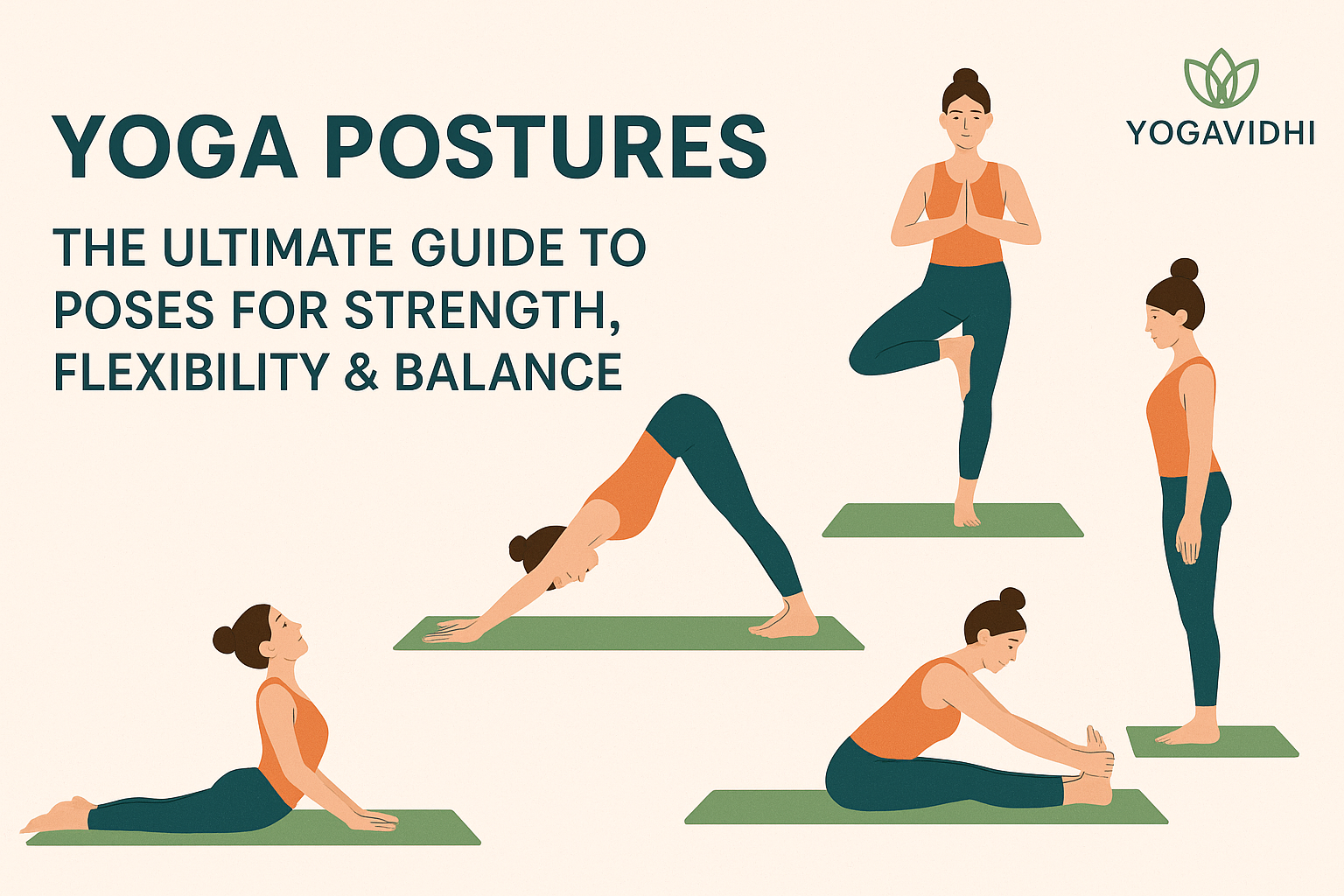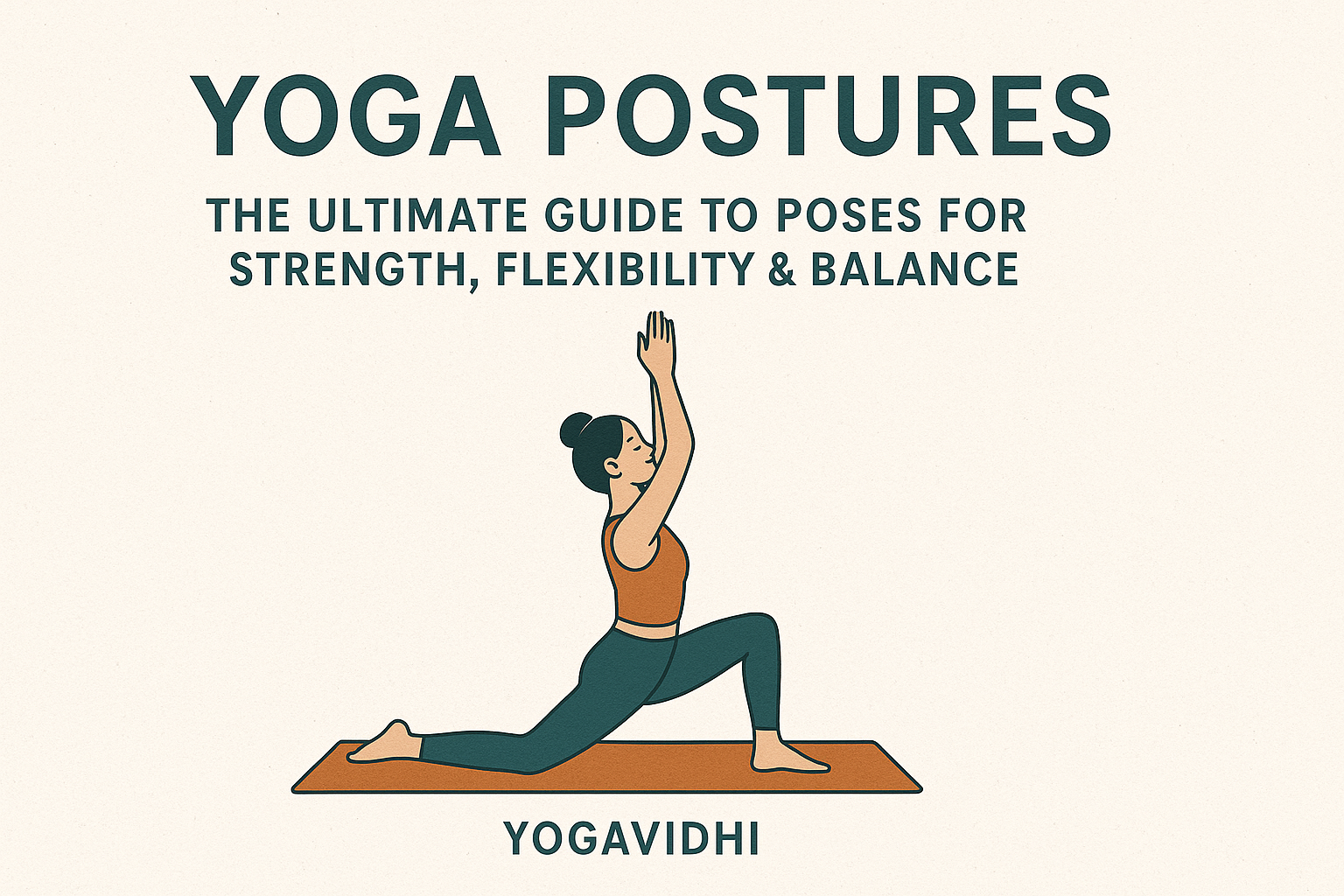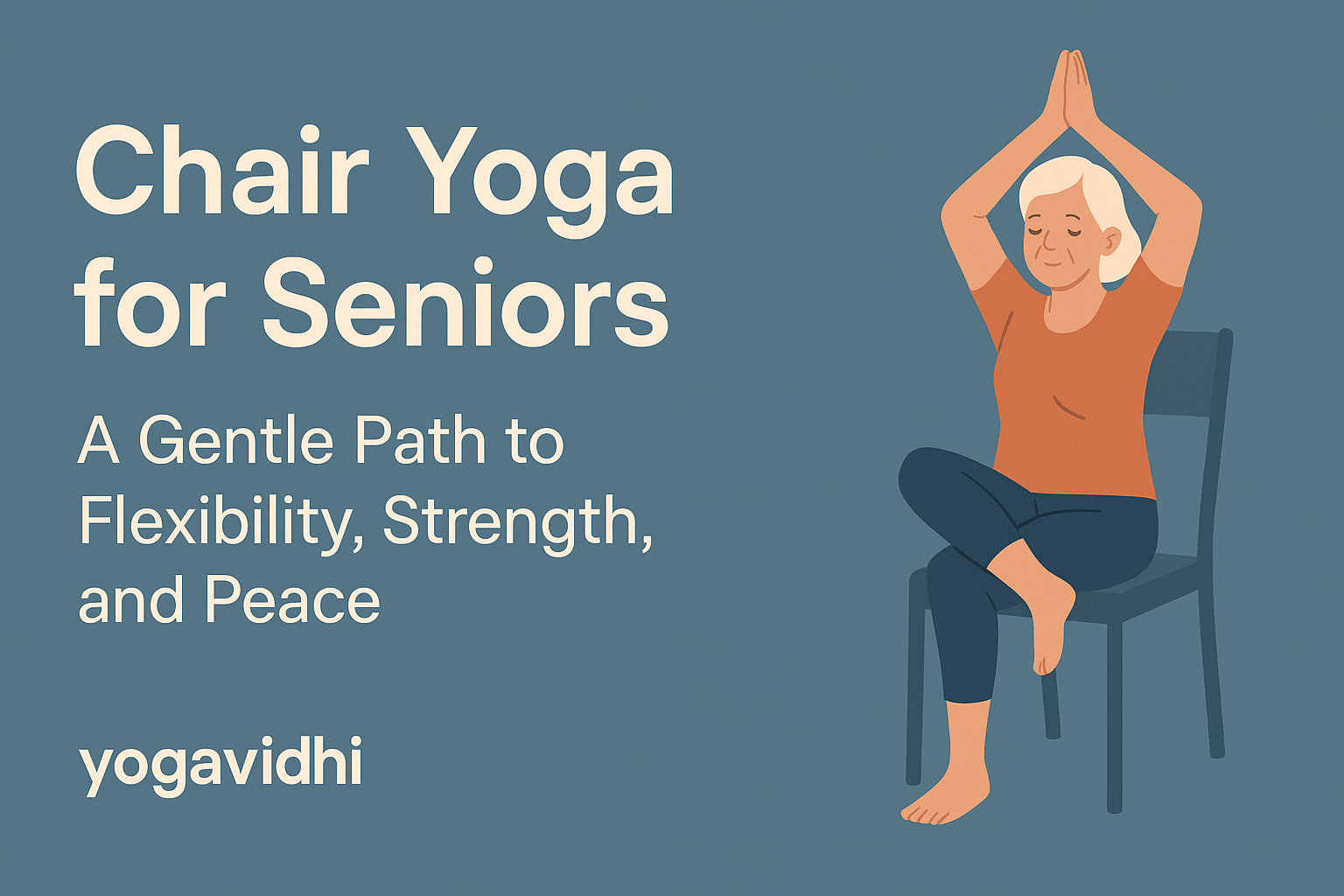Yoga postures, also known as asanas, are the physical movements and positions practiced in yoga to promote physical and mental well-being. These postures go far beyond flexibility and balance—they are powerful tools for building strength, improving posture, calming the mind, and restoring energy.
Whether you are a beginner exploring yoga for the first time or an experienced yogi deepening your practice, mastering yoga postures can transform your body, boost your confidence, and enhance your overall health.
Yoga asanas, or poses, form a core part of yoga practice. These involve maintaining specific body positions, often for an extended time, to enhance physical health, sharpen mental focus, and support emotional well-being. Asanas come in various forms, including standing poses, forward bends, backbends, twists, and inversions, each targeting different areas of the body and mind.
Table of Contents
Why Are Yoga Postures Important?
Yoga postures form the foundation of every yoga practice. They help:
- Build physical strength
- Improve flexibility and range of motion
- Enhance balance and coordination
- Support mental clarity and reduce stress
- Stimulate internal organs and promote circulation
In short, incorporating yoga postures into your daily life nurtures a stronger, more centered version of yourself—inside and out.
Types of Yoga Postures
There are hundreds of yoga postures in different styles of yoga, but they can be categorized into key groups:
1. Standing Yoga Postures
These poses activate the legs, improve posture, and build stamina.
- Mountain Pose (Tadasana): A foundational standing pose that promotes balance.
- Warrior I & II (Virabhadrasana I & II): Great for building lower-body strength and confidence.
- Chair Pose (Utkatasana): Engages the thighs and glutes while promoting endurance.
2. Seated Yoga Postures
These are ideal for improving hip mobility and calming the nervous system.
- Easy Pose (Sukhasana): Perfect for meditation and breathwork.
- Staff Pose (Dandasana): Strengthens the spine and promotes body awareness.
3. Supine (Lying on Back) Postures
These are excellent for relaxation and spinal flexibility.
- Bridge Pose (Setu Bandhasana): Opens the chest and strengthens the glutes.
- Reclined Twist (Supta Matsyendrasana): Releases tension in the spine and detoxifies the organs.
4. Prone (Lying on Stomach) Postures
These energizing poses help with back strength and digestion.
- Cobra Pose (Bhujangasana): Strengthens the lower back.
- Bow Pose (Dhanurasana): Opens the chest and stimulates abdominal organs.
5. Balancing Yoga Postures
Balance is not just physical—it’s also mental. These postures teach focus and presence.
- Tree Pose (Vrikshasana): Enhances concentration and ankle stability.
- Eagle Pose (Garudasana): Improves coordination and mental focus.
6. Inversion Yoga Postures
These poses place your head below your heart, boosting circulation and vitality.
- Shoulder Stand (Sarvangasana): Known as the “queen of poses” for its rejuvenating effects.
- Legs-Up-the-Wall (Viparita Karani): A gentle inversion for beginners.
7. Twisting Yoga Postures
Twists are detoxifying and beneficial for spinal health.
- Half Lord of the Fishes (Ardha Matsyendrasana): Increases spinal mobility and aids digestion.
- Revolved Triangle (Parivrtta Trikonasana): Combines balance, twist, and strength.
Yoga Postures for Beginners
If you’re just starting out, don’t worry—you don’t need to be flexible to practice yoga postures. Start with simple poses that focus on alignment, breath, and relaxation.
Best Beginner Yoga Postures:
- Cat-Cow Stretch (Marjaryasana-Bitilasana): Warms up the spine and improves coordination.
- Child’s Pose (Balasana): A resting pose that gently stretches the back.
- Downward-Facing Dog (Adho Mukha Svanasana): Strengthens the arms and legs while stretching the spine.
- Corpse Pose (Savasana): Encourages deep relaxation at the end of a session.
Tip: Use props like blocks or straps to support your alignment and comfort when learning new postures.
Intermediate and Advanced Yoga Postures
Once you’re confident with beginner poses, gradually introduce intermediate and advanced postures to challenge your strength, flexibility, and focus.
Examples Include:
- Crow Pose (Bakasana): A playful arm balance that builds core strength.
- Wheel Pose (Urdhva Dhanurasana): Opens the heart and strengthens the entire body.
- Headstand (Sirsasana): An inversion that enhances blood flow and mental clarity.
Always warm up before attempting these postures and consider guidance from an experienced yoga teacher.
Therapeutic Yoga Postures
Yoga postures are often prescribed for specific physical and mental conditions. They provide natural relief and healing when practiced mindfully.
Yoga Postures for Common Issues:
- Back Pain: Cat-Cow, Child’s Pose, and Sphinx Pose.
- Anxiety and Stress: Forward folds, Legs-Up-the-Wall, and Savasana.
- Poor Digestion: Twists and gentle backbends.
- Menstrual Discomfort: Reclining Bound Angle Pose (Supta Baddha Konasana) and gentle hip openers.
These yoga postures can be deeply therapeutic and are suitable for all levels.
| Category | Examples of Yoga Postures | Benefits | Ideal For |
| Standing Postures | Mountain Pose, Warrior I & II, Chair Pose | Builds strength, posture, and stamina | All levels |
| Seated Postures | Easy Pose, Staff Pose | Enhances hip flexibility and relaxation | Meditation, breathwork |
| Supine Postures | Bridge Pose, Reclined Twist | Spinal flexibility, relaxation, digestion | Beginners, therapeutic practice |
| Prone Postures | Cobra Pose, Bow Pose | Strengthens back, improves digestion | Core activation, back health |
| Balancing Postures | Tree Pose, Eagle Pose | Improves coordination, focus, and stability | Mental focus, physical balance |
| Inversion Postures | Shoulder Stand, Legs-Up-the-Wall | Boosts circulation, relieves fatigue | Intermediate to advanced, recovery |
| Twisting Postures | Half Lord of the Fishes, Revolved Triangle | Detoxification, spinal health | All levels, core mobility |
| Beginner-Friendly Poses | Cat-Cow, Child’s Pose, Downward Dog, Savasana | Improves mobility, reduces stress | New practitioners |
| Advanced Yoga Postures | Crow Pose, Wheel Pose, Headstand | Builds strength, enhances confidence | Intermediate to advanced |
| Therapeutic Postures | Child’s Pose, Reclining Twist, Sphinx Pose | Stress relief, back pain, hormone balance | Prenatal, seniors, healing |
| Props Used | Blocks, Straps, Bolsters, Blankets | Enhances safety and alignment | Beginners, seniors, Iyengar style |
| Goal-Based Poses | Flexibility (Pigeon), Strength (Plank), Sleep (Legs-Up-the-Wall) | Customizable wellness benefits | Personalized practice |
| Age-Specific Yoga Postures | Kids (Happy Baby), Seniors (Chair Pose), Prenatal (Butterfly) | Tailored to age-specific needs | Children, elderly, pregnant women |
Avoiding Common Mistakes in Yoga Postures
To fully benefit from yoga postures and avoid injury, be aware of these frequent mistakes:
- Holding your breath instead of breathing through the pose.
- Overstretching in an attempt to reach a pose too quickly.
- Ignoring alignment and trying to “look flexible.”
- Comparing yourself to others in class.
- Skipping warm-ups or cool-downs.
Instead, focus on your own body, use props, and move mindfully.
Creating a Balanced Yoga Posture Sequence
Building a yoga sequence that flows smoothly is essential for a well-rounded practice. A good sequence includes:
- Warm-up (e.g., Cat-Cow, gentle stretches)
- Standing postures (e.g., Warrior series)
- Balancing poses (e.g., Tree Pose)
- Seated or supine stretches (e.g., Forward fold, Bridge)
- Twists and core work (e.g., Boat Pose, Reclined Twist)
- Inversions or restorative poses
- Savasana (Final relaxation)
Start with shorter sequences and gradually increase your practice time.
Breath Awareness in Yoga Postures
Breath is the heart of yoga. Coordinating breath with movement enhances focus, calms the nervous system, and makes transitions between postures smoother.
- Inhale: When expanding or lifting (e.g., raising arms, backbends).
- Exhale: When contracting or folding (e.g., forward bends, twists).
Practicing conscious breathing (Pranayama) during yoga postures improves oxygen flow and mindfulness.
Using Props in Yoga Postures (Inspired by Iyengar Yoga)
Props make yoga postures accessible and safer—especially for beginners, seniors, or those recovering from injuries.
- Blocks: Bring the floor closer to you in standing poses.
- Straps: Help you reach in seated forward bends.
- Bolsters & Blankets: Support your body in restorative poses.
Don’t shy away from props—they are a sign of awareness, not weakness.
Yoga Postures by Purpose
Yoga isn’t one-size-fits-all. You can select yoga postures based on your specific goals:
For Flexibility:
- Forward Folds, Pigeon Pose, Reclining Hand-to-Big-Toe Pose.
For Strength:
- Plank Pose, Chair Pose, Warrior III.
For Core Activation:
- Boat Pose, Dolphin Plank, Side Plank.
For Sleep:
- Legs-Up-the-Wall, Child’s Pose, Reclining Twist.
For Emotional Release:
- Camel Pose, Butterfly Pose, Heart-opening backbends.
By practicing with intention, yoga becomes your personalized path to well-being.
Read More: Aerial Yoga: Elevate Your Practice with Strength, Flexibility, and Grace
Read More: Iyengar Yoga: Precision, Alignment, and the Path to Mindful Strength

Yoga Postures for All Ages
Yoga is truly for everyone, at every stage of life.
- Kids: Enjoy fun, playful poses like Cat, Cow, or Happy Baby.
- Seniors: Benefit from gentle yoga postures like Chair Pose, Seated Forward Fold, and Restorative Poses.
- Pregnant Women: Should focus on safe prenatal yoga postures such as Cat-Cow, Butterfly, and Side-Lying Savasana. Avoid deep twists or belly compression.
Always listen to your body, especially during physical transitions in life.
Conclusion: The Transformative Power of Yoga Postures
Yoga postures are more than just physical movements—they are gateways to mindfulness, healing, and self-awareness. Whether you’re standing strong in Warrior Pose or resting deeply in Savasana, every pose has the power to nurture your body and quiet your mind.
Consistency is key. Start simple, stay mindful, and gradually expand your practice. The magic of yoga postures lies not in how far you can stretch but in how deeply you connect with yourself.
FAQs About Yoga Postures
Q. What are the most important yoga postures for beginners?
Ans: Mountain Pose, Cat-Cow, Child’s Pose, and Downward Dog are foundational and beginner-friendly.
Q. How often should I practice yoga postures?
Ans: Aim for 3–5 times a week for visible benefits, but even daily 10-minute sessions can be powerful.
Q. Can yoga postures help with weight loss?
Ans: Yes, especially when combined with breathwork and a consistent practice involving strength-building postures.
Q. Are yoga postures safe during pregnancy?
Ans: Yes, with modifications and approval from your healthcare provider. Prenatal yoga is designed for safety and comfort.
Q. Do I need to be flexible to practice yoga postures?
Ans: Not at all. Yoga builds flexibility over time. Start where you are and grow with practice.
Q. What are the 7 yoga poses?
Ans: Bikram Yoga Poses Explained:
Pranayama – Standing Deep Breathing
Ardha Chandrasana – Half Moon Pose
Utkatasana – Awkward Pose
Garudasana – Eagle Pose
Dandayamana Janushirasana – Standing Head-to-Knee Pose
Dandayamana Dhanurasana – Standing Bow Drawing Pose
Tuladandasana – Balancing Stick Pose
Q. What are the poses in yoga called?
Ans: An asana (Sanskrit: आसन, IAST: āsana) refers to a body posture practiced in both traditional hatha yoga and modern yoga. The word originates from the Sanskrit term meaning “seat.”
Q. What is the king of all yoga poses?
Ans: Shirshasana (Sanskrit: शीर्षासन, IAST: śīrṣāsana), also known as Salamba Shirshasana or the Yoga Headstand, is an inverted pose in modern yoga practice. In classical hatha yoga, it was recognized both as an asana and a mudra, though under various names. Often referred to as the king of all asanas, it holds a place of great importance.
Q. What is the hardest yoga pose?
Ans: What qualifies as the “hardest” yoga pose can vary from person to person, depending on their strength, flexibility, and experience. However, certain poses are generally recognized as particularly challenging due to their intense physical demands. These include the One-Handed Tree Pose (Eka Hasta Vrksasana), Headstand (Sirsasana), and Eight-Angle Pose (Astavakrasana). Other poses like the Crow Pose (Kakasana) and Firefly Pose (Tittibhasana) are also known for their difficulty.
Declaration Note:
We use third-party videos and images on https://yogavidhi.com/ for educational and illustrative purposes. All rights belong to their respective owners. No copyright infringement is intended.



